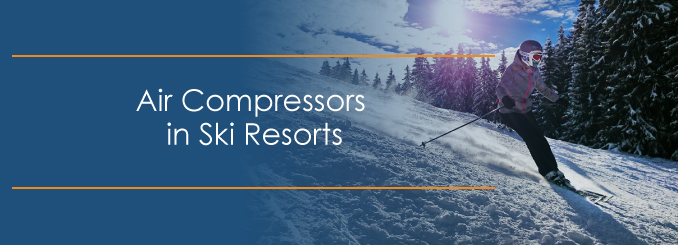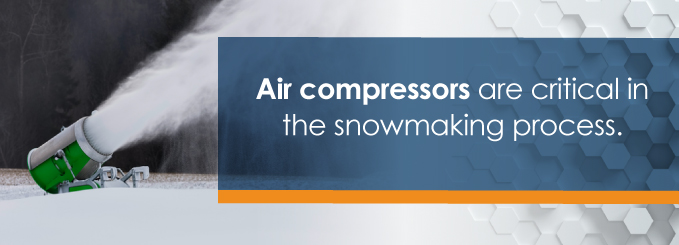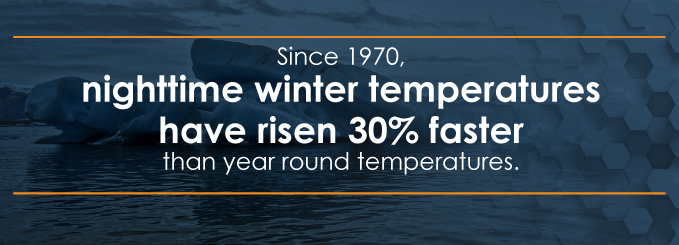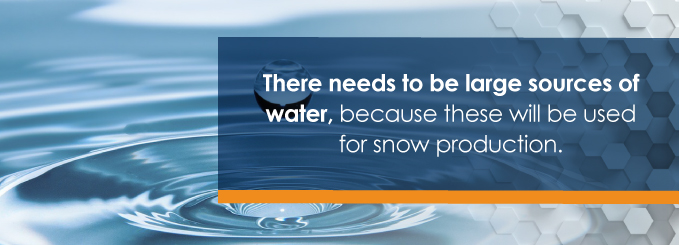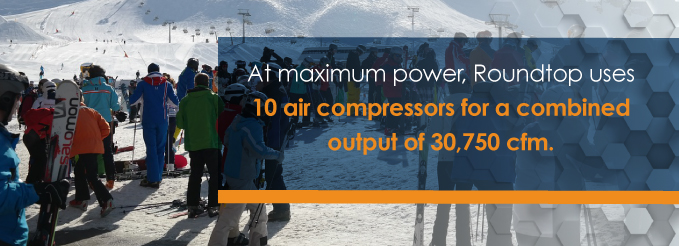Skiing ranges are generally associated with mountains, which most people perceive as being cold enough to produce snow year round. However, natural snow levels are often inefficient for optimal use at ski resorts. These businesses instead rely on artificial snow production, created by pumping cold water high into the air with the power of compressed air.
Now it might seem like a shock that conditions wouldn’t be cold enough to support snow along skiing slopes, but you must consider the following factors:
- Snow only occurs through a combination of coldness and moisture.
- Temperatures generally must be lower than 32°F in order to freeze water.
- Snow must be thick enough to sustain suitable skiing terrain.
Trouble is, these factors aren’t always in place at ski resorts, not even in the wintertime. Even at some of the nation’s best–loved skiing destinations, there’s been an increased need for compressed air to make up for what nature often fails to provide: an abundance of snow for optimal skiing conditions. Consequently, creating artificial snow has become big business in the skiing industry.
Contact Us Learn More Find a Dealer Near You
How are Air Compressors Used in Snowmaking?
In so many ways, the role of air compressors at ski resorts is miraculous, because the machines are critical in the snowmaking process. With high-powered air compressors, resorts can pump pond water high up into the mountains. Once the water arrives, compressed air drives the final role in the process by making the water shoot high enough for the droplets to turn to snow before hitting the slopes. Basically, the role of air compressors in the process of snowmaking can be broken into the following steps:
- Pump water from pipes that connect to ponds.
- Carry water upward to high mountain elevations.
- Shoot water high into the air over slopes.
The time it takes for the snow to fall is crucial, because this is when the water drops cross with the cold ambient air to take the form of snow. If the water were shot directly down upon the slope, it wouldn’t have time to make this change in properties, and would simply fall along the slope in liquid form. At high altitudes, these wet slopes would quickly freeze, but it would form an icy texture up and down, and would lack the fluffy quality needed for skiing. Not only would skis lack traction, but skiers could easily slip, fall and injure themselves on the hard ice.
Why Air Compressors are Needed for Snowmaking
The skiing industry is largely about winter. After all, when people think of recreational activities for the wintertime, snow sports are second only to holiday get–togethers in terms of free–time fun. In a sense, skiing could be seen as the winter equivalent to swimming or surfing during the summer months.
Between the months of November and February, ski resorts can often expect to see some of their biggest business. According to Climate Central, since 1970, nighttime winter temperatures have risen 30 percent faster than year round temperatures. As a result, ski operations have turned to artificial snow technology to remain profitable.
Environmental Benefits of Ski Resort Air Compressors
Perhaps the best thing about ski resort air compressors is the eco–friendliness they make possible. It’s all down to the way that water gets reused at ski resorts time and again through the process of snowmaking. First, the water sits in the pond. When the need arises, it’s sucked through the pipes to make its way upward. Meanwhile, old snow melts into the pond to regenerate the water level.
Up the mountain, the water is shot through the pipes and out of snow guns via air compressors. The water gets misted into droplets that form tiny snowballs, which make the skiing experience possible for resort guests. After time, the snow melts and makes its way back down to the pond, which will have since sent more water upward to repeat the process. Soon enough, then water will make its way back up for another turn at being snow — all thanks to the power of air compressors.
Steps have been taken to reduce emissions at ski resorts across the U.S. At Pennsylvania’s Seven Springs Mountain Resort, electric air compressors are now employed in lieu of diesel–based machines. The compressors are used to send water through more than 1,000 guns across 285 acres of skiing range.
The Benefits of Snow Made from Air Compressors
As the skiing industry looks to the future, air compressors will play a larger role in the preparation of slopes for skiers. In many ways, this helps the skiing industry because it provides a safer and stable type of snow for skiing down hills at fast speeds. The benefits of artificial snow include:
- Consistency — Unlike snowflakes, artificial snow doesn’t consist of tiny branches that break off or rapidly melt away.
- Thickness — Whereas snowflakes are mostly full of air, artificial snow is soft yet firm, and therefore more supportive.
- Roundness — Artificial snow is round rather than star shaped, and while the balls shrink over time, the roundness remains.
- Reliability — As millions of balls accumulate along the slopes through the artificial snowmaking process, resorts are able to provide users with safer and more reliable slopes to ski on.
Even though it takes high-powered machinery and complex piping networks to produce, artificial snow is one of the best man–made resources in the industry of outdoor snow sports.
Essential Conditions for Snow at Skiing Resorts
For the adventurous, skiing is one of the most fun and exhilarating outdoor activities. Regardless of your age, chances are that once you’ve experienced the thrill of sliding down snow slopes at fast speeds, you’ll want to relive the experience time and again. Likewise, you’ll want to bring friends and loved ones along for the experience. Even if someone close to you has never set foot on a pair of skies, you’ll wish to initiate them, so that they too can experience the unique thrills of descending on high slopes. For many, skiing is the ultimate expression of freedom.
However, for all the fun that skiing provides, there are a number of conditions that need to be in place for the whole experience to be possible. For starters, elevations must be high enough in order to support snow. If a slope was placed on an altitude warm enough to melt snow, it wouldn’t be safe for anyone taking part in the fun. Secondly, there needs to be enough snow on the ground. If the snow thins out or lacks sufficient fluff and fullness, it won’t have the right consistency to support hundreds of passing skiers each day.
Weather, of course, won’t always support these conditions. Basically, you can cancel out the possibility of skiing under natural circumstances if you don’t have the following factors in place:
- Elevations high enough for snowy temperatures and skiing.
- Sufficient amounts of snow with proper consistency along the slopes.
- Temperatures that are cold enough to keep the snow intact.
At ski resorts where circumstances don’t favor sufficient levels of natural snow, there’s plan B, which relies on a whole host of other factors. First off, there needs to be large sources of water, because these will be used for snow production. Secondly, there needs to be a complex piping system that can carry the water across miles of distribution. After all, the water needed to produce snow cannot be stored at altitudes where it would freeze. Therefore, the main ingredient for snow production, water, must remain thousands of feet below the slopes until it is needed.
Natural vs. Artificial Snow
In some ways, the unavailability of natural snow is a blessing in disguise for skiers. Fact is, artificial snow is thicker and more durable than natural snowflakes due to the shape and consistency from the snowmaking process. Whereas natural flakes are brittle and full of air, artificial snow is shaped like soft, thick balls. Natural flakes eventually break up around the edges and gradually melt. Artificial snow, by contrast, will slowly shrink over time, but retain its round shape. Therefore, conditions along slopes are a lot more consistent and reliable when the grounds are covered with artificial snow.
Artificial snow comes from the same element as natural snowflakes: frozen water. During winters, when the weather fails to offer the proper mix of coldness and moisture for snow to fall, machinery is used to produce artificial flakes that are more durable than the real thing. Granted, it’s not a simple process, as it requires high–tech systems of pipes and ski resort air compressors to approximate the complex processes of nature.
Natural snow is primarily comprised of air, which explains the fluffy, six–sided shape of snowflakes. As such, snowflakes retain their initial shape for only short periods of time before the branches disintegrate. With this loss of fluffiness, the snow loses its ability to provide optimal support for skiers.
By contrast, snow produced through the air compressors at ski resorts is shaped like tiny balls. Over time, these balls will shrink, but they never lose their roundness. Due to this consistency, artificial snow is actually preferable to snowflakes at many ski resorts.
The Process of Snowmaking at Ski Resorts
In order for snow to fall naturally, there needs to be sufficient moisture within temperatures of 32°F or lower. When snow fails to materialize at such temperatures, it’s due to lack of moisture. In order to produce snow on ski slopes despite the lack of snowfall, ski resorts like Roundtop Mountain Resort in Lewisberry, Pennsylvania, pump water upward from ponds of cold water to produce artificial round snow, which is then misted over the skiing area.
So how are air compressors used in snowmaking at Roundtop? The process begins at a 35 million–gallon pond, from which water is sent upward via piping and turned into snow through air compressors. The results are artificially snowed along the slope, and the tiny round snow balls provide the setting for skiers to descend at fast, exhilarating speeds. As snowballs melt, the water drains back to the pond to begin anew with the snowmaking process.
Five vertical turbines pump 4,000 gallons of water from the pond per minute. At maximum power, Roundtop uses 10 air compressors for a combined output of 30,750 cfm. However, cooling is needed to temper the heat of compressed air, which can be as hot as 180°F — not a suitable temperature for the production of snow. With the use of air coolers, the compressed air is lowered to around 36°F, which makes things much more conducive to snowmaking.
With the cold air and water now ready, each are distributed across separate sets of pipes that extend across nine miles of slope area. The snow is made with combinations of compressed air and water at hydrant pairs.
Roundtop relies on two different gun types in the snowmaking process: the air/water gun and the airless gun. The former uses compressed air to shoot water upward into the cold air. Meanwhile, the airless gun relies on a fan to send water upward. The guns are mounted on towers to ensure that the water is sent as high as possible, because this allows time for the water mist to freeze as it descends upon the slopes. The colder and dryer the snow, the better foundation it makes for skiers.
A similar snowmaking process is employed at ski resorts around Lake Tahoe, where water is pumped in advance for storage on the mountaintop and ultimately used as needed. Miles of piping are used to transport water underground to more than 1,200 stations across the slopes. The water is pumped through a system of air compressors that generate 28,500 cfm per minute.
Quincy — Providing Quality Air Compressors to Ski Resorts
Skiing will remain a much loved outdoor recreational activity for as long as people can ascend high slopes. However, nature is not a reliable source for perfect snow making conditions. Fortunately, compressed–air technology makes it possible for ski resorts to keep slopes paved with snow, regardless of natural circumstances.
For nearly a century, Quincy Compressor has been a leading air compressor manufacturer with products used throughout the commercial and industrial sectors. At ski resorts, our compressors can be used in large systems to send water upward through pipes and out through guns for dispersion into snow along slopes used by skiers. To learn more about the vast range of air compressors and related products that Quincy has to offer, click over to our sales and service locator page today.


